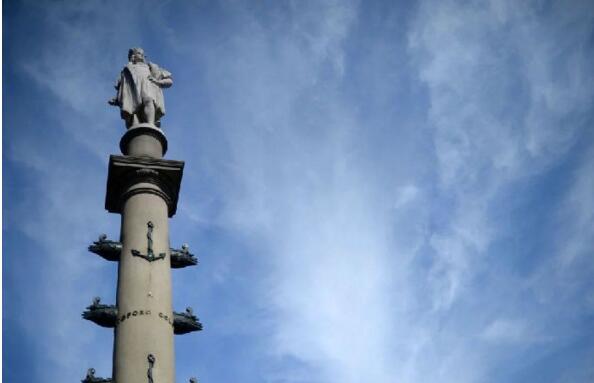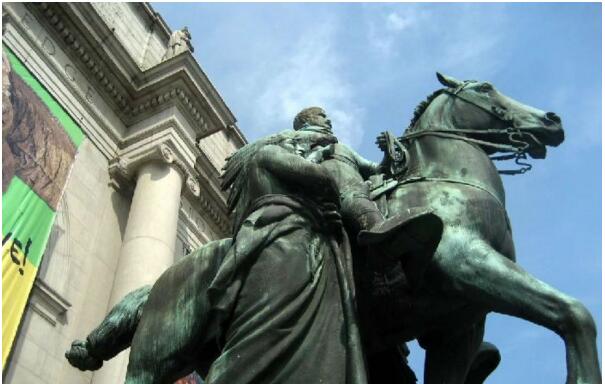
Christopher Columbus's sculpture is located in the Columbus Circle in New York City. Photo: Courtesy of Andrew H. Walker/Getty Images
When you talk about dismantling American controversial memorial sculptures, please exclude New York.
After months of consideration and debate, the Mayor’s Advisory Committee on how to deal with urban art, monuments and markers finally decided not to dismantle the commemorative sculptures of politicians including Christopher Columbus and Teddy Roosevelt. Moreover, these sculptures will be displayed along with the nameplates of the relevant historical events. The sculpture of the particularly controversial 19th century doctor J. Marion Sims will be moved to another part of the city.
“The liquidation of the overall history will be an extremely complicated process, and there is no simple solution,†Mayor Bill de Blasio said in a statement. “So the way we take it is to add some subtle Historical content to restore history, rather than simply eliminating everything (sculpture)."
Not only that, he added, “We will have a hard time examining what historical figures have been left out, and where New York needs to be supplemented (historical content) to achieve the diversity of public spaces and realize the values ​​of the city of New York.â€

New York chose to move Dr. James Marion Sims's sculpture from East Harlem to the Greenwood Cemetery in Brooklyn, where Sims was buried. Image: courtesy of Matt Green of I'm Just Walking, via Flickr, Creative Commons
Controversial sculptures such as the 15th century explorer Columbus have become the focus of debate in recent months. Columbus enslaved Native Americans and treated them violently, while Dr. J. Marion Sims was a slave. Women pioneered the experiment of gynecologists. In September, Mayor Bai Sihao set up an advisory committee to decide how to deal with these historical sculptures, as well as the memorial buildings he called the “hate symbol of urban facilitiesâ€.
The New York Committee held hearings in five blocks in November to allow residents to weigh on these sensitive issues. The committee received thousands of responses to the questionnaire. These questionnaires suggest three possible solutions: “add supplementary educational materials (eg in the form of nameplates), or shift the sculpture to another public or private space, or commission new public art on the source of the original sculpture. Interpret."
According to the Associated Press, New York finally adopted the above three methods.
The sculpture of Dr. Sims, currently in East Harlem, will be transferred to his Greenwood cemetery in Brooklyn.

Teddy Roosevelt's sculpture at the American Museum of Natural History in New York. Photo: Courtesy of Wally
According to a report issued by the City of New York, the Columbus sculpture, one of the landmarks near Central Park, "has presented a great challenge to the committee." Most members advocated retaining the original sculpture, in part because "it is a proud symbol of American Italians and other Americans."
Immigrants once saved money to build the sculpture. He built it during the period of the KKK against Catholics, and one year after 11 Italian-Americans were lynched. Finally, the committee recommended retaining the sculpture, but at the same time they commissioned a monument to commemorate Native Americans and some temporary works of art to commemorate the legend of Columbus.

New York City Mayor Bai Sihao Twitter. Photo: Thanks to Bai Sihao
The Teddy Roosevelt sculpture outside the American Museum of Natural History in New York is even more controversial. The monument is surrounded by cartoon African and Native American images. When the committee was unable to determine its fate, the mayor proposed a vote to break the "draw". Opponents attacked the sculpture in October, splashing it with fake blood and calling it "patriarchy, white supremacism, and settler colonialism." However, due to the intervention of Mayor Bai Sihao, the sculpture remains in place, at least for now.
The decision to keep another monument intact has raised some concerns. A Nazi collaborator named Henri Philippe Petain also named one of the 206 nameplates in the "Heroes Canyon" in Lower Manhattan, "Heroes Canyon" to commemorate New York's previous Ticker-tape Parade . In August, Mayor Bai Sihao promised to remove this (Nazi) mark. However, the Commission recommends that instead of renaming the multi-site installation, it is better to choose between retaining the Petain nameplate or clearing all the nameplates.
Want to know more about copper carving prices, copper carving wholesale, bronze sculpture joining, copper carving procurement related information, can visit http://tongdiao.99114.com/
Jiangmen Mingcheng Button Co., Ltd. , https://www.btn-button.com